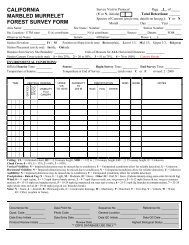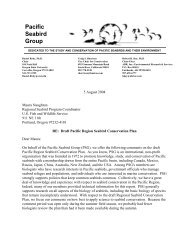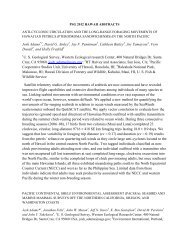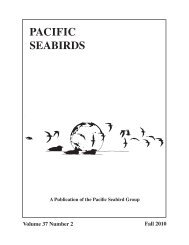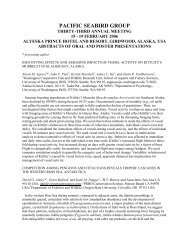abstracts of oral and poster presentations - Pacific Seabird Group
abstracts of oral and poster presentations - Pacific Seabird Group
abstracts of oral and poster presentations - Pacific Seabird Group
You also want an ePaper? Increase the reach of your titles
YUMPU automatically turns print PDFs into web optimized ePapers that Google loves.
chick-rearing constraints occur. After chick hatching, terns utilize the river less, except in high water level years<br />
at the Reservoir, when fish availability is low. I will discuss how both constraints on foraging behavior affect<br />
salmon predation by terns.<br />
MECHANISMS THAT SHAPE SEABIRD DISTRIBUTION IN TIME AND SPACE: HYDROGRAPHY<br />
AND SEABIRDS IN THE SOUTHEASTERN NORTH SEA<br />
Nele Markones (markones@ftz-west.uni-kiel.de) <strong>and</strong> Stefan Garthe; Research <strong>and</strong> Technology Centre,<br />
University <strong>of</strong> Kiel, GERMANY<br />
Since 1990, seabird distribution in the southeastern North Sea has been recorded by German scientists<br />
following the internationally st<strong>and</strong>ardised seabirds at-sea method. Meanwhile, the general distribution patterns<br />
during the different seasons can be described for all common species. To reveal the mechanisms that shape <strong>and</strong><br />
control these distribution patterns, a suite <strong>of</strong> studies that took place during the non-breeding season was analysed<br />
to investigate the relationships between seabird distribution <strong>and</strong> hydrography. For this purpose, we related the<br />
distribution <strong>of</strong> all common species in the southeastern North Sea to horizontal <strong>and</strong> vertical pr<strong>of</strong>iles <strong>of</strong> different<br />
hydrographic parameters. Analyses revealed that most <strong>of</strong> the common species showed a significant, or at least a<br />
positive, correlation to a selection <strong>of</strong> different hydrographic structures. On the larger scale, these hydrographic<br />
phenomena consisted <strong>of</strong> distinct water masses with differing salinity, temperature, <strong>and</strong> water transparency. At a<br />
smaller scale, frontal structures, which were created e.g., by local upwellings or river-plume fronts, were<br />
important. With the hydrographic situation in the southeastern North Sea being highly dynamic, we expect that<br />
seabird distribution patterns also underlie a high variability due to their link to hydrographic features. By<br />
analysing the exact nature <strong>of</strong> the relationship between seabird distribution <strong>and</strong> hydrography, it should be<br />
possible to evaluate seabird distribution patterns <strong>and</strong> predict their variability.<br />
XANTUS'S MURRELET MONITORING PROGRAM AT SANTA BARBARA ISLAND, CALIFORNIA,<br />
1983–2003<br />
Paige L. Martin (paige_martin@nps.gov) <strong>and</strong> Catherine A. Schwemm; Channel Isl<strong>and</strong>s National Park, Ventura,<br />
CA USA<br />
From 1983 to 2003, Channel Isl<strong>and</strong>s National Park (with assistance from other groups) monitored<br />
samples <strong>of</strong> nests <strong>of</strong> Xantus's Murrelets (Synthliboramphus hypoleucus) at Santa Barbara Isl<strong>and</strong>, California, to<br />
examine nesting phenology, occupancy, egg fate, <strong>and</strong> site productivity. Nesting phenology varied widely<br />
between years, with egg-laying between February <strong>and</strong> July. Occupancy <strong>and</strong> annual productivity declined over<br />
the study period, consistent with population declines reported for this colony by other studies. Annual<br />
productivity ranged widely, from 0.39–1.21/nesting attempt. Although annual predation <strong>of</strong> eggs by deer mice<br />
(Peromyscus maniculatus elusus) ranged widely (0.0–68.9%), we found no relationships between variation in<br />
mouse density <strong>and</strong> levels <strong>of</strong> egg predation, hatching success, or site productivity. This monitoring program<br />
should be improved <strong>and</strong> continued annually, in conjunction with long-term studies <strong>of</strong> murrelets, mammalian <strong>and</strong><br />
avian predators, prey resources, <strong>and</strong> other human impacts to assess <strong>and</strong> model population changes better at the<br />
largest colony in California.<br />
FORAGING BEHAVIOR OF STREAKED SHEARWATER IN JAPAN<br />
Kei Matsumoto* 1 (Kei-mts01@av6.mopera.ne.jp), Nariko Oka 2 , Daisuke Ochi 1 , Yutaka Watanuki 1 , Fumihito<br />
Mutou 3 , <strong>and</strong> Yoshiyuki Baba 4 ; 1 Graduate School <strong>of</strong> Fisheries Science, Hokkaido University, Hakodate JAPAN;<br />
2 Research Division, Yamashina Institute for Ornithology, Chiba JAPAN; 3 Ocean Research Institute, The<br />
University <strong>of</strong> Tokyo, Tokyo JAPAN; 4 Laboratory <strong>of</strong> Nature Conservation, SCS, Kyushu University, JAPAN<br />
Maximal dive depths <strong>of</strong> several species <strong>of</strong> <strong>of</strong>fshore albatrosses <strong>and</strong> petrels have been reported recently.<br />
However, little is known about dive depth <strong>and</strong> daily foraging pattern <strong>of</strong> coastal feeding sheawaters. Streaked<br />
Sheawaters are endemic in eastern Asia <strong>and</strong> are believed to feed in coastal waters during the breeding period.<br />
We examined the diving behavior <strong>and</strong> diet <strong>of</strong> Streaked Shearwaters breeding on Mikura Isl<strong>and</strong>, southern Japan.<br />
Basing on time-depth data collected using small data-loggers, sheawaters dived less than 7 m deep during<br />
foraging trips <strong>of</strong> 1 to 13 days. Mean dive depth <strong>and</strong> duration were 1.5 ± SD 0.9 m <strong>and</strong> 4.6 ± SD 1.2 sec,<br />
respectively. Most dives occurred in the daytime. During long trips (>5 days), birds fed in cold waters (



